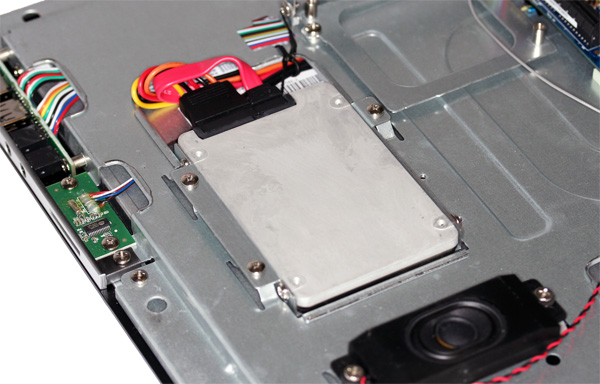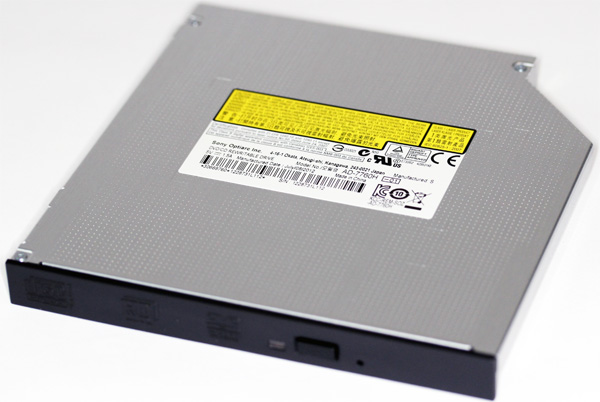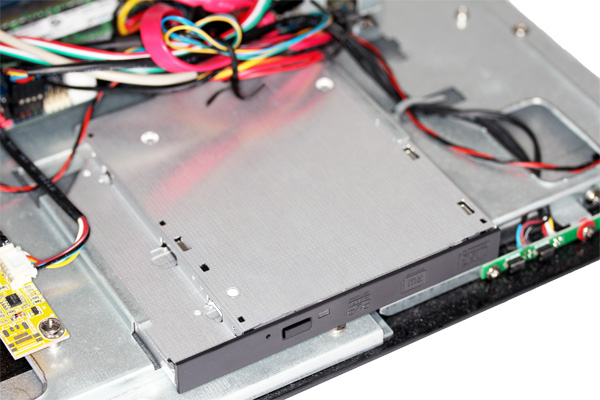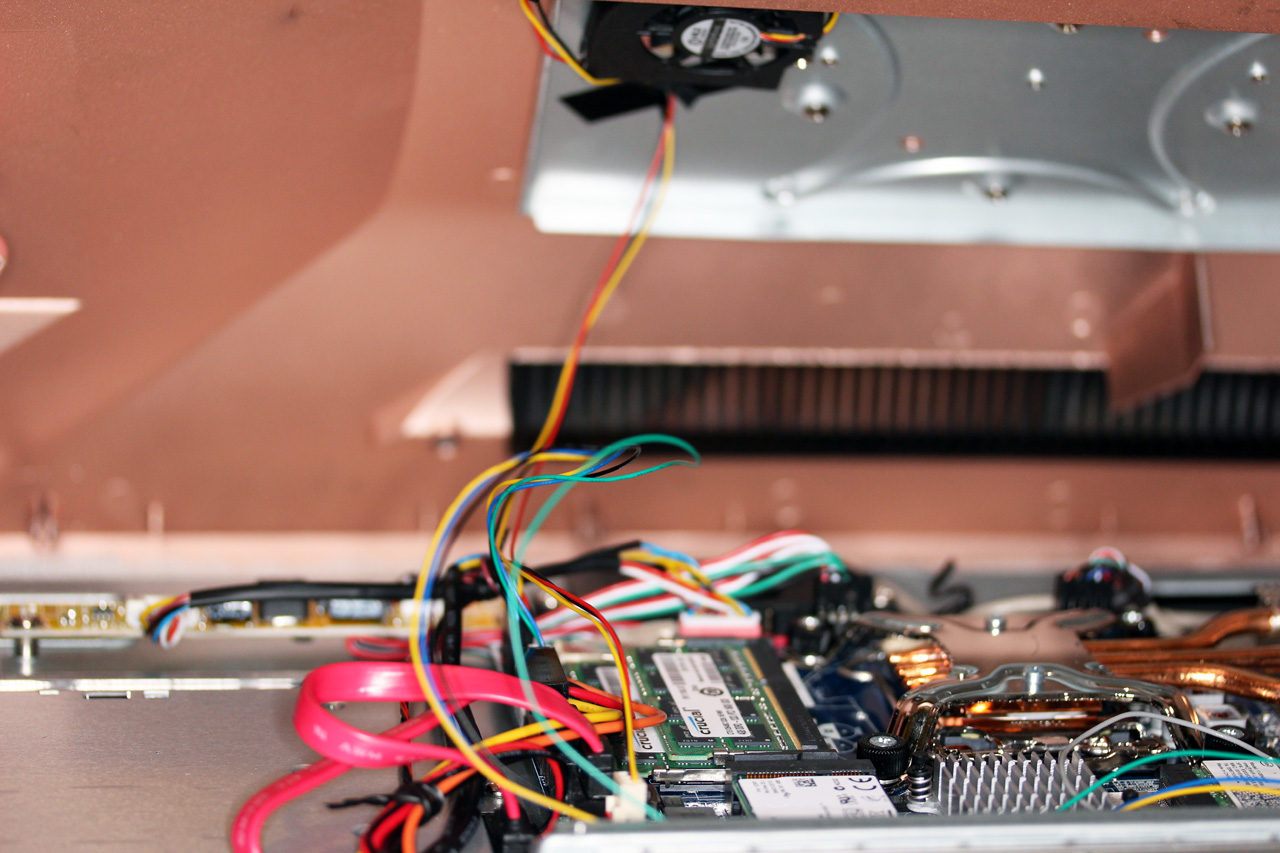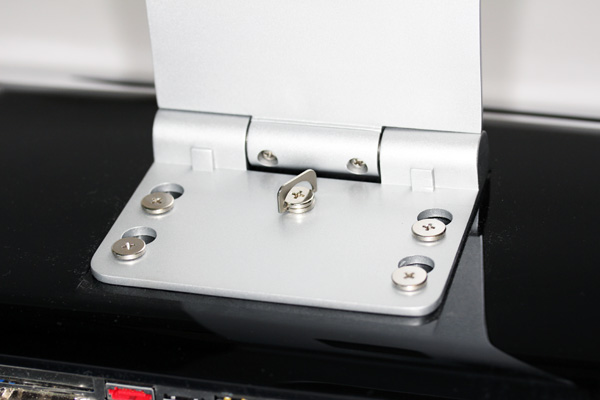Take That, iMac?: Build Your Own All-In-One PC
We've long envied the good looks of highly-integrated iMacs, even as we derided their lack of hardware flexibility and nasty price premiums. Well, now it's possible to build your own all-in-one using components of your choosing. Ready to save some money?
More Solid-State Storage
Even with an 80 GB SSD populating our motherboard’s mSATA slot, more NAND-based storage couldn’t hurt, right?
We’re using a 500 GB Western Digital Scorpio Black drive spinning at 7200 RPM for our iMac price comparison. But we’d much rather be launching apps from a 300 GB SSD 320. So, that’s what we installed in the one spot available for 2.5” drives.
Installing Intel's 300 GB SSD 320
Screwed into a caddy and secured, the 300 GB SSD 320 ensures we have plenty of space for Windows and anything else we might want to install.
An 8x DVD Writer From Sony
An 8x DVD+/-RW drive from Sony is both fast enough and functional enough to keep us happy. It’d be nice to have Blu-ray read capabilities as well, but that’d nearly double the price of our selection.
Of course, if you want to spend some of what you’d save on an iMac, splurging on a Blu-ray combo drive for less than $60 isn’t an entirely bad idea.
A Precise Fit Is The Key To A Pro Finish
Slid into place and secured by an included bracket, Sony's optical drive integrates cleanly with the rest of our all-in-one.
Truly, one of the most important factors in our decision to present this little project is an end result that we’d be happy to have on our desk at work or school. A neatly tucked-away DVD burner helps keep the system’s lines clean as you look at it head-on.
Get Tom's Hardware's best news and in-depth reviews, straight to your inbox.
Familiar Bits And Pieces, Just Smaller
The completely built-up platform consists of copious memory, an 80 GB mSATA SSD 310, a mini-PCI Express wireless card, and a Sandy Bridge-based processor—in our case, a Core i5-2400S, after all of our testing was said and done.
Closing Up
Closing the chassis back up is as easy as it was to open. There are five screws holding the plastic back onto the body. Simply mate the two sides together, make sure everything snaps into place firmly, and re-attach the screws.
First, though, be sure to connect the power lead for the fan attached to the plastic lid. There’s an open header on the motherboard you can use.
An I/O-Rich Back Panel
Here’s what the bottom of chassis looks like closed up, and with the Intel DH61AG motherboard installed. In addition to the two USB 2.0 ports on the side of enclosure, the platform itself exposes an additional two USB 2.0 ports, a pair of USB 3.0 ports, 1/8” audio connectors, gigabit Ethernet, HDMI, eSATA, and DVI display output.
The left-most connector is for power. Without room for an internal power supply, you’re forced to lean on an external brick. Fortunately, cooperation between Intel and its Thin Mini-ITX ecosystem partners means that all-in-ones and their building blocks are being designed with the same power sources, thermal ceilings, and cooling solutions in mind. You shouldn't find Thin Mini-ITX motherboards without that vital connector. Otherwise, you'd have no way to get this thing up and running.
Securing The Stand
Mounting the Loop enclosure’s stand is a simple matter of sliding four large cut-outs over similarly-sized screw heads and sliding the stand down.
One Last Step...
From there, thread in a fifth and final screw to lock the stand into place. It tilts up and down, but doesn’t swivel side to side (it doesn’t adjust vertically, either). So, you’ll need to arrange the all-in-one facing right at you and tilt into the best possible viewing position.
Taking Pride In A Sharp-Looking Build
I’m not going to sit here and try to claim that these first-gen Thin Mini-ITX-based all-in-ones are as polished as iMacs. Their cameras are inferior, they don’t include AMD’s mobile graphics processors (and are consequently unsuitable for gaming), and their speakers are pretty weak. Moreover, the fact that Apple supports its entire platform is a boon to folks unwilling to crack their systems open and troubleshoot hardware.
However, our alternative isn't at all bad. Nothing about it feels cheap or hacked together. And we have a lot more flexibility over what goes into it than Apple offers. Processing, memory, storage, and networking are all fairly tunable to suit your budget or performance desires. Access to a more potent GPU would be the one thing we wish we could change.
-
cangelini clownbabyNice build. Are there any similar chassis with a touch screen?Reply
Not that I've seen, but I'm waiting for Intel to get back to me on this prior to the Win 8 launch. -
cangelini baddassngno one tried to hackintosh this?And unleash the wrath of the Apple haters?Reply
Don't the guys who want Apples just buy iMacs? :P -
abhijitkalyane Nice build for a second surfing/media machine. If a similar mobo is available for AMD APUs, it could make a decent low-end gaming machine too. All in all, it is good to know that there are options to build an all in one DIY style. Kudos to Loop for the nice chassis.Reply -
CaedenV That looks great!Reply
Throw in an i3 Ivy bridge, 4GB of ram, and a small SSD and you would have the ultimate office machine. With the onboard video output exposed you can even hook up a 2nd monitor to this and have what would appear to be 2 tethered monitors without a PC... -
razor512 the stock intel boards are generally easier to hackintosh since the board in an actual imac is more or less a stock intel board with a custom PCB layout to fit their cases and a special DRM chip added. other than that, they have a few minor firmware changes which gives the board a more MAC style ID.Reply -
nukemaster A review of the screen quality would also be nice. I am betting at the price its TN.Reply
very nice to see Intel make that cooler to help anyone looking to go super low profile/all in one.
caedenvThat looks great!Throw in an i3 Ivy bridge, 4GB of ram, and a small SSD and you would have the ultimate office machine. With the onboard video output exposed you can even hook up a 2nd monitor to this and have what would appear to be 2 tethered monitors without a PC...Now if you could get a second loop monitor only. That would look very different at the office :) -
Yargnit I'd be curious if you could under volt a standard 77w Ivy bridge CPU enough to fit within the cooling capabilities of this unit? (Once the BIOS issues are solved anyways) Without being able to fit a discrete GPU, getting HD4000 in there vs 2000/3000 would at least open up some low end casual gaming if you could. And from what I recall the IB CPU'S under volt fairly well at stock frequencies.Reply -
cangelini Now that 55 W i3s are available with HD Graphics 4000, you could go that route as well (like you said, once the firmware issues are rectified).Reply

